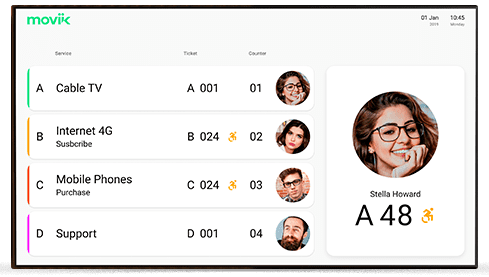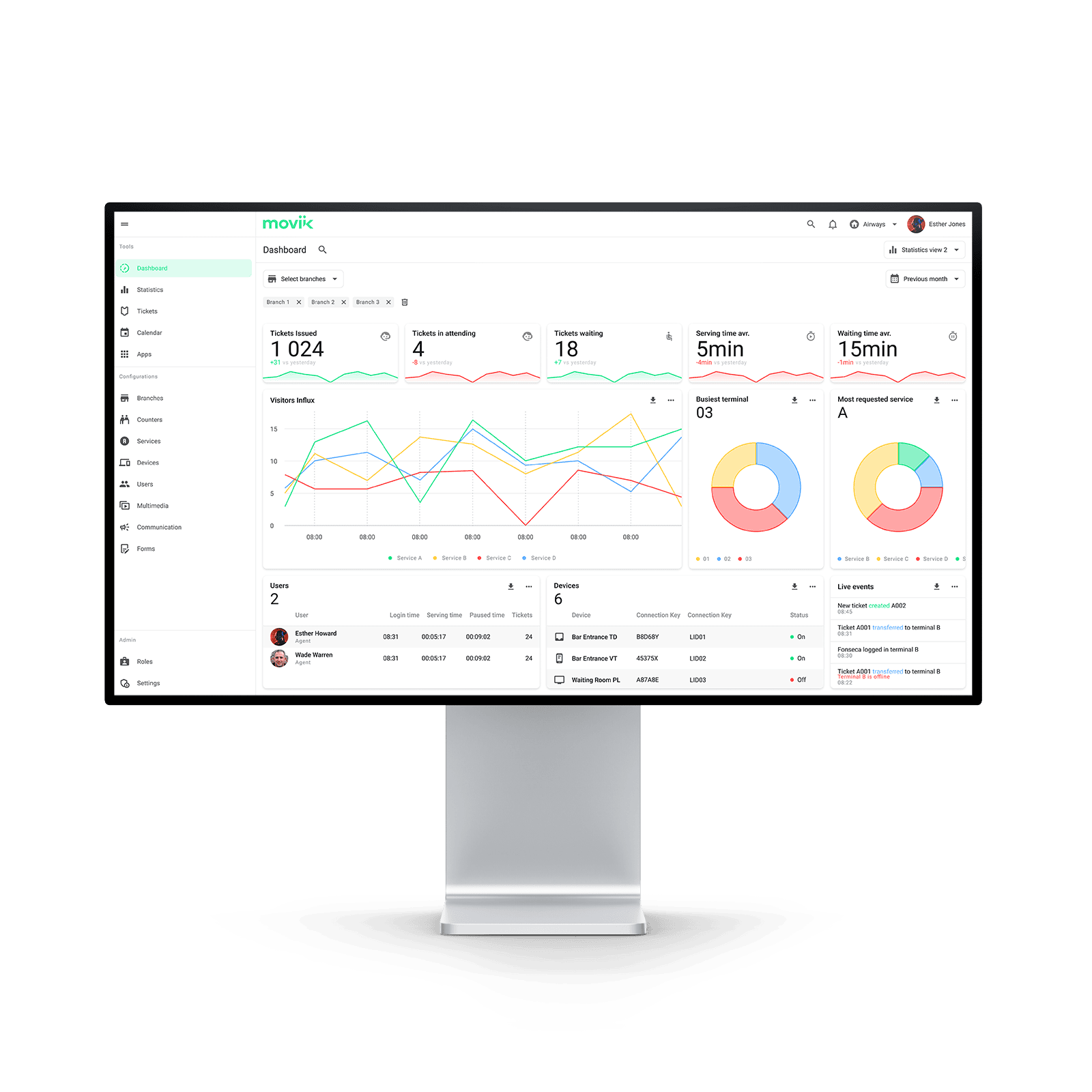When businesses think about queues, the first thought is often: “How can we reduce waiting times?”
And indeed, shorter waits are important because they improve operational efficiency, reduce frustration, and increase satisfaction.
However, as someone with extensive experience in queue management across sectors like retail, banking, healthcare, and transport, I can tell you: reducing wait times is just the beginning.
A strategically designed queue management system transforms waiting into a positive customer experience, builds trust, and ultimately drives loyalty. Modern queue management combines transparency, proactive communication, environment, personalization, and actionable data insights.
Let’s explore how each element reflects what your queues reveal about your business and how it can be improved.
Transparency: the mirrow of trust
Transparency: the mirrow of trust
Practical applications:
Digital displays or mobile apps showing real-time position in the queue;
Clear signage explaining service steps, especially during peak periods;
Standardized service-level expectations (SLAs) for common interactions.
Businesses that implement transparency find that even if total waiting time remains the same, customer satisfaction improves because the emotional experience of waiting is managed. Over time, this consistency fosters loyalty and repeat visits.
Communication: proactive and personalized
Communication: proactive and personalized
Transparency alone doesn’t guarantee a smooth experience. Keeping customers informed at every step reduces stress, increases trust, and signals professionalism.
Key strategies:
Send push notifications or SMS updates: “Your turn is coming up. Please proceed to counter 2.”;
Enable two-way communication for quick changes, such as rescheduling appointments;
Display live updates on screens for customers waiting on-site.
For instance, in clinics, notifying patients about expected delays along with a brief explanation improves satisfaction and lowers no-shows. In retail, informing customers when their order or service is ready prevents crowding and encourages timely engagement.
Environment: comfort shapes perception
Environment: comfort shapes perception
The space where customers wait can heavily influence how long a wait feels. Comfortable seating, well-organized layouts, and visually engaging areas reduce stress and make waiting more tolerable
Design recommendations:
Ergonomic seating arranged to ensure comfort and personal space;
Screens providing queue updates, helpful information, or entertainment;
Clear signage and floor markings to guide customers efficiently
Even small environmental tweaks, such as adding informative screens or subtle branding elements, can improve satisfaction and positively impact how customers perceive your business.
Personalization: attention to detail matters
Personalization: attention to detail matters
Acknowledging individual customers enhances their perception of your service. Personal touches make waiting feel less generic and more customer-centric.
Examples of personalization:
Addressing returning customers by name on digital kiosks or mobile apps;
Offering priority lanes for VIP or pre-booked clients;
Using historical data to anticipate demand and adjust service levels accordingly
These gestures create an emotional connection. Customers feel valued, which increases the likelihood of repeat visits and loyalty.
Data insights: turning waiting into actionable intelligence
Data insights: turning waiting into actionable intelligence
Queues provide valuable feedback about business operations. Advanced queue management systems track wait times, peak periods, and customer flow, transforming everyday interactions into actionable insights.
Use cases:
Align staffing with anticipated peaks to prevent long waits
Identify bottlenecks in service delivery for continuous improvement
Measure the impact of process changes on customer satisfaction and operational efficiency
For example, a branch using real-time analytics discovered a consistent midday bottleneck and adjusted staffing, reducing average wait times by 4 minutes and increasing transaction completion rates.
Strategic advantage: queues as a business lens
Strategic advantage: queues as a business lens
When transparency, communication, environment, personalization, and data are combined, queue management moves beyond operational necessity and becomes a strategic asset. Businesses improve efficiency while reinforcing trust, engagement, and customer loyalty.
Implementation tips:
Pilot digital notifications or kiosks in one location before scaling;
Monitor metrics like wait times, customer satisfaction, and conversion rates;
Continuously iterate based on real-time feedback to optimize operations.
This approach transforms queues from a passive inconvenience into an opportunity to enhance the customer journey, strengthen loyalty, and generate measurable business impact.
Queues are more than lines, they’re mirrors of your business performance and culture. A well-managed queue demonstrates empathy, efficiency, and respect for customer time.
Reducing wait time is essential, but transforming the waiting experience is what sets great organizations apart.
By investing in a modern queue management system that blends technology, design, and data, you turn waiting into a moment that builds loyalty, boosts satisfaction, and drives growth.
When businesses think about queues, the first thought is often: “How can we reduce waiting times?”
And indeed, shorter waits are important because they improve operational efficiency, reduce frustration, and increase satisfaction.
However, as someone with extensive experience in queue management across sectors like retail, banking, healthcare, and transport, I can tell you: reducing wait times is just the beginning.
A strategically designed queue management system transforms waiting into a positive customer experience, builds trust, and ultimately drives loyalty. Modern queue management combines transparency, proactive communication, environment, personalization, and actionable data insights.
Let’s explore how each element reflects what your queues reveal about your business and how it can be improved.
Transparency: the mirrow of trust
Transparency: the mirrow of trust
Practical applications:
Digital displays or mobile apps showing real-time position in the queue;
Clear signage explaining service steps, especially during peak periods;
Standardized service-level expectations (SLAs) for common interactions.
Businesses that implement transparency find that even if total waiting time remains the same, customer satisfaction improves because the emotional experience of waiting is managed. Over time, this consistency fosters loyalty and repeat visits.
Communication: proactive and personalized
Communication: proactive and personalized
Transparency alone doesn’t guarantee a smooth experience. Keeping customers informed at every step reduces stress, increases trust, and signals professionalism.
Key strategies:
Send push notifications or SMS updates: “Your turn is coming up. Please proceed to counter 2.”;
Enable two-way communication for quick changes, such as rescheduling appointments;
Display live updates on screens for customers waiting on-site.
For instance, in clinics, notifying patients about expected delays along with a brief explanation improves satisfaction and lowers no-shows. In retail, informing customers when their order or service is ready prevents crowding and encourages timely engagement.
Environment: comfort shapes perception
Environment: comfort shapes perception
The space where customers wait can heavily influence how long a wait feels. Comfortable seating, well-organized layouts, and visually engaging areas reduce stress and make waiting more tolerable
Design recommendations:
Ergonomic seating arranged to ensure comfort and personal space;
Screens providing queue updates, helpful information, or entertainment;
Clear signage and floor markings to guide customers efficiently
Even small environmental tweaks, such as adding informative screens or subtle branding elements, can improve satisfaction and positively impact how customers perceive your business.
Personalization: attention to detail matters
Personalization: attention to detail matters
Acknowledging individual customers enhances their perception of your service. Personal touches make waiting feel less generic and more customer-centric.
Examples of personalization:
Addressing returning customers by name on digital kiosks or mobile apps;
Offering priority lanes for VIP or pre-booked clients;
Using historical data to anticipate demand and adjust service levels accordingly
These gestures create an emotional connection. Customers feel valued, which increases the likelihood of repeat visits and loyalty.
Data insights: turning waiting into actionable intelligence
Data insights: turning waiting into actionable intelligence
Queues provide valuable feedback about business operations. Advanced queue management systems track wait times, peak periods, and customer flow, transforming everyday interactions into actionable insights.
Use cases:
Align staffing with anticipated peaks to prevent long waits
Identify bottlenecks in service delivery for continuous improvement
Measure the impact of process changes on customer satisfaction and operational efficiency
For example, a branch using real-time analytics discovered a consistent midday bottleneck and adjusted staffing, reducing average wait times by 4 minutes and increasing transaction completion rates.
Strategic advantage: queues as a business lens
Strategic advantage: queues as a business lens
When transparency, communication, environment, personalization, and data are combined, queue management moves beyond operational necessity and becomes a strategic asset. Businesses improve efficiency while reinforcing trust, engagement, and customer loyalty.
Implementation tips:
Pilot digital notifications or kiosks in one location before scaling;
Monitor metrics like wait times, customer satisfaction, and conversion rates;
Continuously iterate based on real-time feedback to optimize operations.
This approach transforms queues from a passive inconvenience into an opportunity to enhance the customer journey, strengthen loyalty, and generate measurable business impact.
Queues are more than lines, they’re mirrors of your business performance and culture. A well-managed queue demonstrates empathy, efficiency, and respect for customer time.
Reducing wait time is essential, but transforming the waiting experience is what sets great organizations apart.
By investing in a modern queue management system that blends technology, design, and data, you turn waiting into a moment that builds loyalty, boosts satisfaction, and drives growth.







